Catheter Treatment Team in Mongolia, May 2025
6/17/2025
April 26 – May 2, 2025: First Catheter Treatment Support Activity of the Year
From April 26 to May 2, 2025, we conducted the first catheter treatment support activity of the year in Mongolia. During this same period, another team was carrying out regional health checkup activities in Bayan-Ölgii. In this report, we will focus on the catheter team’s activities at the National Center for Maternal and Child Health (NCMCH) in the capital city, Ulaanbaatar.
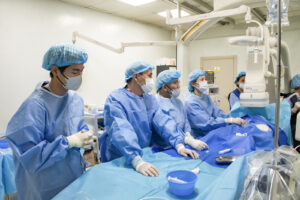
in the cathe room
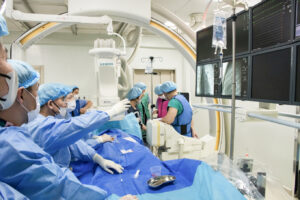
Treatment by the Japanese-Mongolian joint staff, led by Dr. Higaki
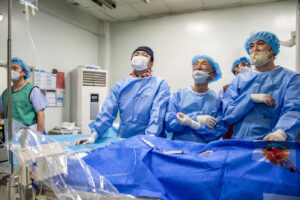
Doctors looking at the monitor
“Numerous Challenges Remain”
Since the end of the COVID-19 pandemic, there have been significant changes to the personnel structure at the NCMCH pediatric cardiology department. Along with these staffing changes, there has also been a major shift in the device supply system. In fact, during the previous year, there were frequent problems with the unavailability of devices in commonly used sizes, which caused treatments to be delayed or canceled. Unfortunately, the same issue arose again during our May 2025 visit.
Additionally, a key leader of the local medical team, who was supposed to be trained through the Heart Saving Project, was away on overseas training and could not participate in this activity. Moreover, due to an unorganized list of patients received before departure, we were unable to set the activity goals or target patients in advance, which posed additional challenges.
“Achievements in May 2025”
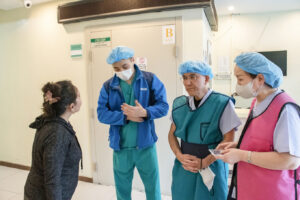
Explanation to the patient’s parents
The activity schedule and outcomes for this trip were as follows:
Day 1
Morning: Echocardiogram screening of 106 patients. We selected potential catheter treatment cases from these.
Afternoon: One catheter treatment case.
Day 2
All Day: Catheter treatments, 4 cases, and 1 diagnostic catheter.
Day 3
Morning: Echocardiogram screening at the Shine Mongol Harumafuji Gakuen.
Afternoon: 3 catheter treatment cases.
Final Day
1 catheter treatment case, 1 diagnostic catheter, and 1 transesophageal echocardiogram.
Total Catheters: 11
9 treatment catheters
2 diagnostic catheters
1 transesophageal echocardiogram.
“Young Doctors and Doctors from Regional Hospitals with enthusiasm”
Due to the absence of the core local doctors, the Heart Saving Project team took the lead in guiding 3 young doctors from NCMCH. Along the way, we also held a meeting with the NCMCH pediatric hospital director to discuss the shortcomings on their side. They apologized, explaining that they had been overwhelmed with work and couldn’t manage all of the tasks on time.
Despite the absence of the core doctor, the 3 young doctors demonstrated great enthusiasm, as they participated in almost all of the catheter procedures, accompanied the rounds, and performed their own medical examinations and echocardiographic evaluations. However, it was clear that they still lacked experience, and it will be necessary for them to improve their planning and procedural skills moving forward.
April 27 (Day 1)
Together with the young doctors from NCMCH, we conducted echocardiogram screenings for 106 patients. At the same time, five pediatric cardiologists and internists from regional hospitals in Mongolia visited Ulaanbaatar for an echocardiogram training. We had the opportunity to directly demonstrate echocardiograms and provide guidance. This initiative seems to be part of a larger effort to enable regional hospitals in Mongolia to conduct screenings.
In the afternoon, we performed a catheter treatment for patent ductus arteriosus using the devices we brought from Japan. Unfortunately, the second case was canceled after the patient developed a fever following anesthesia.
April 28 (Day 2)
We conducted 4 catheter treatments and 1 diagnostic catheter. As in previous days, the devices brought from Japan were used, as local stock was insufficient. A new shipment of devices arrived on this day, but it only included 10 units of the same size, which was not ideal.
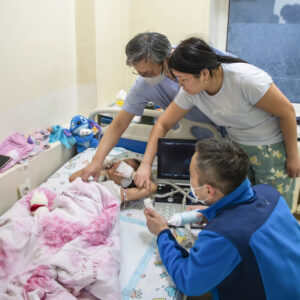
Patient rounds after treatment
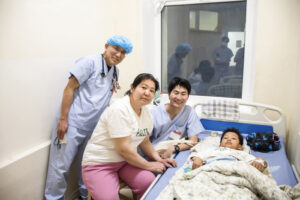
A commemorative photo with the child and his mother after treatment
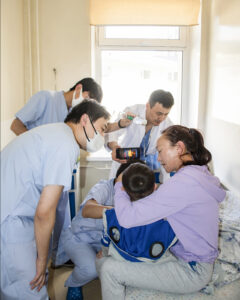
A young Mongolian doctor (male in a white coat) attending rounds after treatment
“The Courage and Energy Given by the Students of the Shine Mongol Harumafuji Gakuen”
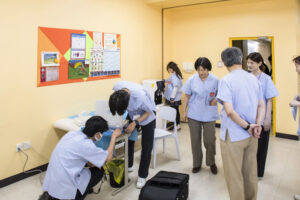
Preparing for school health checkups

Polite students at the reception desk

First graders
In the morning, we visited the Shime Mongol Harumafuji Gakuen, where we conducted secondary heart echo screenings for children who had been flagged for follow-up after a nationwide electrocardiogram (ECG) screening for first-grade students. Fortunately, all the children screened were found to have no issues with their hearts. The reason for the high number of referrals was that the ECG settings had been adjusted for adults, causing the machine to detect normal values in children as abnormal.
This was the beginning of Mongolia’s school-age children’s heart screening initiative. Moving forward, it will be important to provide feedback on these results and offer advice.
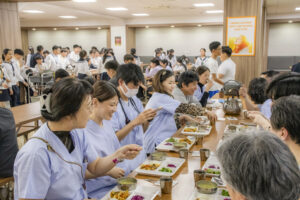
Lunch with the students in the school cafeteria
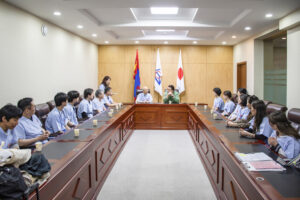
After the examination, the results will be reported to the school.
After the screening, we reported the results to the school and had lunch with the students. Despite the challenging start to the project, the Heart Saving Project doctors were greatly energized by the students’ polite, bright, and cheerful demeanor. It was a refreshing and positive experience for everyone.
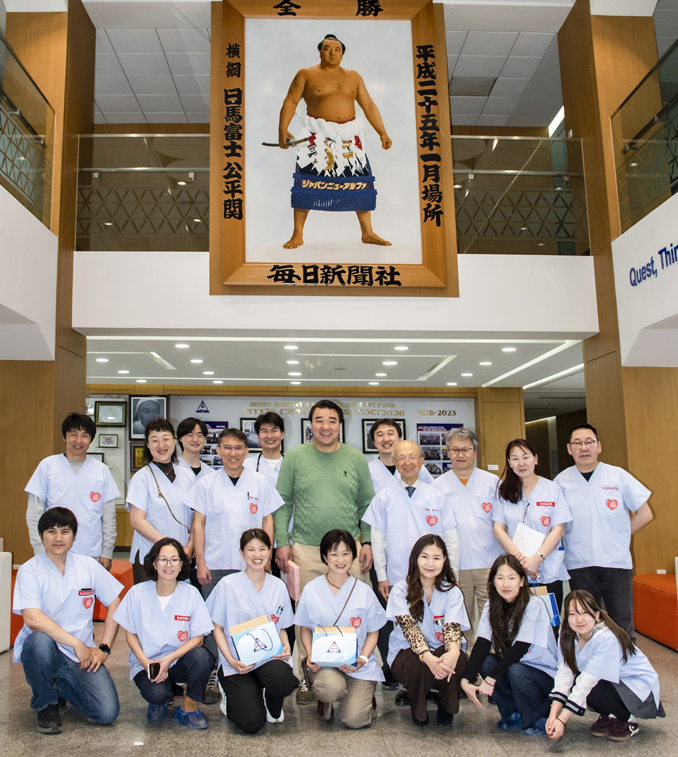
A commemorative photo after the medical examination. Harumafuji is in the center.
In the afternoon, we returned to NCMCH and conducted 3 catheter treatments.
April 30 (Final Day)
We completed 1 catheter treatment, 1 diagnostic catheter, and 1 transesophageal echocardiogram.
“The Importance of Information Sharing”
Throughout the activity, there were several instances where treatment was interrupted due to a lack of information sharing among the staff involved in the catheter procedures. Additionally, there were cases where the patient’s family did not share important information with the hospital. Building a culture of information sharing in Mongolia is challenging, as there seems to be a tendency to withhold information, but for the purpose of effective patient treatment, it is essential to emphasize that information should be shared among all parties involved. This will be a key focus going forward.
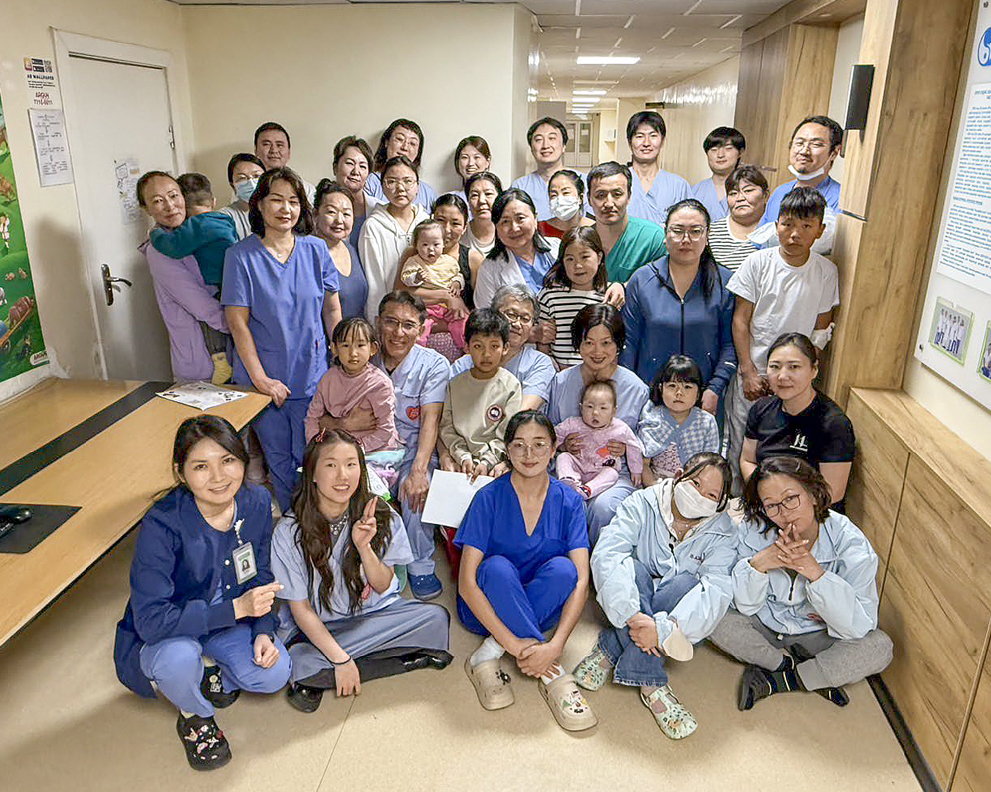
2025.May,Staff, patients, and parents gather
Finally, I would like to express my deepest gratitude to all those who participated in this activity despite their busy schedules, to those who supported us, and to those who backed this project financially to ensure its success. Thank you very much for your continued support.
